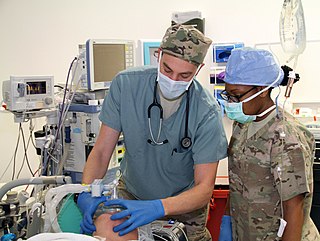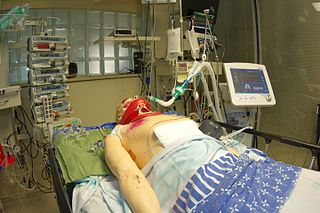
Anesthesiology, anaesthesiology, or anaesthesia is the medical specialty concerned with the total perioperative care of patients before, during and after surgery. It encompasses anesthesia, intensive care medicine, critical emergency medicine, and pain medicine. A physician specialized in anesthesiology is called an anesthesiologist, anaesthesiologist, or anaesthetist, depending on the country. In some countries, the terms are synonymous, while in other countries they refer to different positions, and anesthetist is only used for non-physicians, such as nurse anesthetists.

Baylor College of Medicine (BCM) is a medical school and research center in Houston, Texas, within the Texas Medical Center, the world's largest medical center. BCM is composed of four academic components: the School of Medicine, the Graduate School of Biomedical Sciences; the School of Health Professions, and the National School of Tropical Medicine.
The University of Texas Southwestern Medical Center is a public academic health science center in Dallas, Texas. With approximately 23,000 employees, more than 3,000 full-time faculty, and nearly 4 million outpatient visits per year, UT Southwestern is the largest medical school in the University of Texas System and state of Texas.
The American Society of Anesthesiologists (ASA) is an educational, research and scientific association of physicians organized to raise the standards of the medical practice of anesthesiology and to improve patient care.

Cooper University Hospital is a teaching hospital and biomedical research facility located in Camden, New Jersey. The hospital formerly served as a clinical campus of Robert Wood Johnson Medical School and the University of Medicine and Dentistry of New Jersey. Affiliated with Cooper Medical School of Rowan University, the hospital offers training programs for medical students, residents, fellows, nurses, and allied health professionals. In partnership with the University of Texas MD Anderson Cancer Center, Cooper operates a comprehensive cancer center serving patients in New Jersey and the Delaware Valley.

The Center for Emergency Medicine of Western Pennsylvania is a multi-hospital consortium based in Pittsburgh, Pennsylvania. It is claimed to be one of the world's premiere centers of Emergency Medicine and EMS development. It currently ranks sixth for residencies in emergency medicine by reputation.
In the United States, anesthesia can be administered by physician anesthesiologists, an anesthesiologist assistant, or nurse anesthetist.
Edward D. Miller Jr. was the Frances Watt Baker, M.D. and Lenox D. Baker Jr., M.D. Dean of the Medical Faculty at Johns Hopkins University and the Chief Executive Officer of Johns Hopkins Medicine from 1997 to 2012.
Paul Frederick White, FANZCA is a researcher in anesthesiology, research consultant at Cedars-Sinai Medical Center at Los Angeles, retired professor and former holder of the Margaret Milam McDermott Distinguished Chair of Anesthesiology at The University of Texas Southwestern Medical Center at Dallas, and the author and editor of several journals and textbooks on the subject. With over 450 peer-reviewed publications and authorship in 9 anesthesiology textbooks, White has helped shape and revolutionize the field of ambulatory anesthesia and intravenous anesthesia.
David L. Reich is an American academic anesthesiologist, who has been President & Chief Operating Officer of The Mount Sinai Hospital, and President of Mount Sinai Queens, since October 2013.

The University of Florida College of Medicine – Jacksonville is the largest of the three University of Florida Health Science Center Jacksonville colleges — medicine, nursing and pharmacy. The college's 16 clinical science departments house more than 440 faculty members and 380 residents and fellows. The college offers 34 accredited graduate medical education programs and 10 non-standard programs.
Certified anesthesiologist assistants (CAAs) are highly trained master’s degree level non-physician anesthesia care providers. CAAs are integral members of the anesthesia care team as described by the American Society of Anesthesiologists (ASA). This designation must be disambiguated from the Certified Clinical Anesthesia Assistant (CCAA) designation conferred by the Canadian Society of Respiratory Therapists. All CAAs possess a baccalaureate degree, and complete an intensive didactic and clinical program at a postgraduate level. CAAs are trained in the delivery and maintenance of all types of anesthesia care as well as advanced patient monitoring techniques. The goal of CAA education is to guide the transformation of student applicants into competent clinicians.

Sean C. Mackey is an American scientist, anesthesiologist and pain medicine specialist. Since 2012, he has served as the Redlich Professor of Anesthesiology, Perioperative and Pain Medicine, Neurosciences and Neurology at Stanford University. He has been the Chief of the Division of Pain Medicine since 2007 and the Director and Founder of the Systems Neuroscience and Pain Laboratory (SNAPL) since 2002. Previously, he practiced anesthesiology and co-founded Stanford's regional anesthesia program in 2000.

MSR – The Israel Center for Medical Simulation is Israel's national institute for simulation-based medical education (SBME) and patient safety training. It is located at the Chaim Sheba Medical Center in the Tel HaShomer neighborhood of Ramat Gan, in the Tel Aviv District. MSR is internationally recognized as leader in patient safety simulation-based training.
William H. Adcox is the Chief Security Officer for the University of Texas MD Anderson Cancer Center and a pioneer of Threat Safety Science in healthcare. He is also the Chief of Police and Chief Security Officer at the University of Texas at Houston Police Department, which is a component of the University of Texas System. He has had a longstanding career as a police officer and Deputy Chief of Police in El Paso, Texas.
The Medical Tactical Certificate Training Program, also known as Med Tac, is a global bystander rescue care training program that focuses on life-saving actions that can be performed by non-medical bystanders for the eight leading preventable causes of death to children, youth, and adults. In urban areas in the United States, professional first responders arrive at the scene of an emergency after approximately 10 minutes. Immediate rescue care by bystanders is most effective within three minutes of an event. Treatment within this time has been found to have a significant effect on rates of survival and permanent harm. Created and expanded upon after the dramatic increase in active shooter and terrorism events, Med Tac integrates the American Heart Association Heartsaver CPR/AED Training Program, or the American Red Cross equivalent training, and the Stop the Bleed Program sponsored by the United States Department of Homeland Security and American College of Surgeons.

Alex Bekker is a physician, author and academic. He is a professor and chair at the Department of Anesthesiology, Rutgers New Jersey Medical School. He is also professor at the Department of Physiology, Pharmacology & Neurosciences. He serves as the Chief of Anesthesiology Service at the University Hospital in Newark.

Allison Walsh Kurian is an American medical oncologist. She is a Professor of Medicine and Epidemiology & Population Health at Stanford University and an oncologist at the Stanford Cancer Institute.

Lee Alan Fleisher is an American anesthesiologist. In 2020, Fleisher was named Chief Medical Officer and Director of the Centers for Medicare & Medicaid Services Center for Clinical Standards and Quality. He previously served as Chair of Anesthesiology and Critical Care at the Perelman School of Medicine at the University of Pennsylvania.
Alex Macario is an American anesthesiologist, academic and author. He is a vice-chair for education, a professor in the Department of Anesthesiology, Perioperative and Pain Medicine, and program director for the anesthesiology residency at Stanford University School of Medicine.









